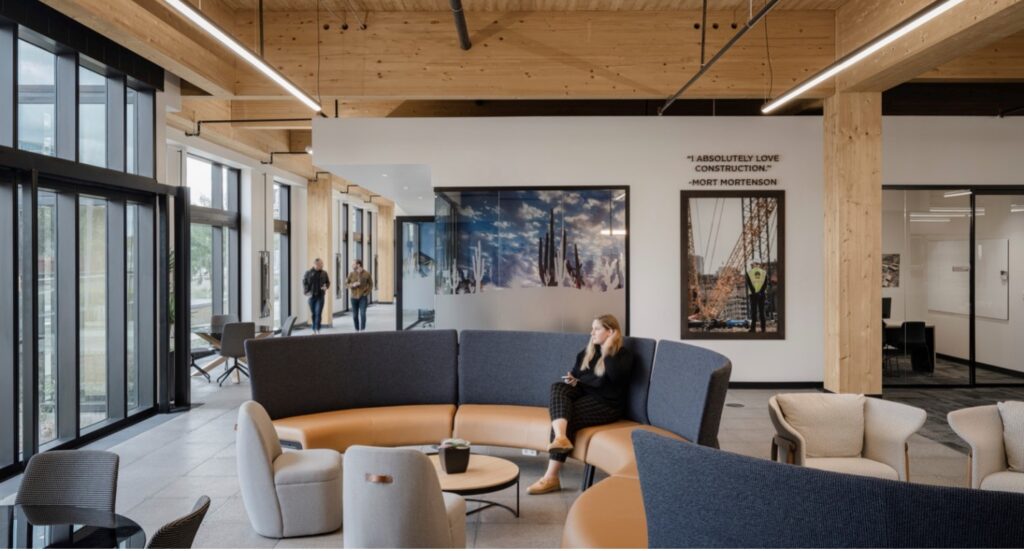- In most cases, it’s much more cost-effective for organizations to initially put infrastructure in place to reduce and track all emissions.
- Increasingly, it will be up to designers, architects and other experts to help organizations work through energy efficiency requirements and metrics.
- Hopefully, this will be to the benefit of the planet and humanity, with significantly reduced carbon emissions.
This article was originally written by RSP’s Jeremi Van Wave for Work Design Magazine.
It finally feels like something is happening. After decades of working toward a more resilient, lower carbon future through design, regulations and the public seem to be catching up. We may finally have the critical mass to change, or at least mitigate the trajectory of, climate change.
On top of that, we may be looking at a healthier, more inclusive road ahead. Companies everywhere are rethinking what that all means for their workforce and office space.
New Regulations, New Opportunities
The Securities and Exchange Commission released expansive new rules last year that we expect to be codified imminently. The new regulations would require companies to disclose much more information about their climate impact. While we won’t know for sure what’s in the final document until it is released, many of us believe it will tie to what the Greenhouse Gas (GHG) Protocol defines as Scope 1 and Scope 2 emissions. That is, those elements that are directly correlated to the energy efficiency of buildings.
Truly, this could be the biggest regulatory shift for office buildings since the Americans with Disabilities Act. Publicly traded companies will now have to track, report and show progress toward emissions goals, and this will almost certainly trickle down to all companies over time.
All workplaces will have to be designed with these metrics in mind. And both workplace designers and clients will be looking toward the future of these regulations—not just what the current rules say, but also what the requirements will be in 3, 5 or 20 years. In most cases, it will be much more cost-effective to do the work now and put the infrastructure in place to reduce and track all emissions.
In fact, we already see a future where the regulations go much further and require Scope 3 tracking. That means not just tracking the carbon footprint of a company’s real estate assets, but emissions across the entire supply chain. Already, companies that do significant work (more than $50 million) with the Federal Government must report and track this information. It’s only a matter of time before this expands to include smaller government contractors as well.
The EU has even stricter reporting requirements and any company working or planning to work in Europe is already tracking this data. Increasingly, it will be up to designers, architects and other experts to help organizations of every size work through these requirements and metrics. And, hopefully, this will be to the benefit of the planet and humanity, with significantly reduced carbon emissions.

No More Greenwashing
The pandemic ushered in any number of social changes, not least of which was the overnight shift to remote work. At the same time, for those of us paying attention to ESG (Environmental, Social and Governance) reports, we saw a lot of companies claiming to have reached their interim climate commitments years ahead of schedule because of reduced greenhouse gasses.
The truth, though, is that a lot of those emissions were just shifted to people’s homes, rather than a true reduction. Likewise, there is a greater scrutiny from regulators, some resulting in litigation, over companies’ sustainability claims. Add to that the greater sophistication of the market to understand and vet claims, and there is going to be a huge demand for better data and assurances related to the environmental metrics, the built environment, and ESG.
As we are finding through our discussions with some of our clients who have significant real estate portfolios, everything in the new guidelines will need to be verified. If a company says they planted 1,000 trees, it will need to be corroborated. If an organization says it created 500 well-paying jobs in a developing country, it will need to be verified. Even for companies that have been reporting on their ESG, Scope 1 and Scope 2 metrics for years, this added scrutiny will require better accuracy and more details.
And that leads to the question that we have been exploring since March 2020. How much square footage do organizations really need to devote to their workplaces and what kinds of metrics should we be tracking to have the biggest impact on sustainability? Certainly, the office is not going away. But we continue to talk to Fortune 500 companies about the smartest ways to shed office space and what that means for their climate commitments and ESG goals. Again, it all has to be tracked and reported. Eventually, there will be targets to hit so that collectively, we can hit net zero by 2050.
What New Regulations Mean for Designers and Clients
As more companies start measuring and reporting on their ESG efforts, designers will have to continue to up their game. There is the modeling and prediction side of creating an energy-efficient workplace, and the operations and implementation side. Better and better technology will continue to be baked into workplace designs to measure what we need to know today (energy consumption, for example) and what we will want to know in the future (the amount of carbon associated with the entire operation).
Our clients are becoming better informed about their options in making their workplaces more efficient and less carbon intensive. As metrics are identified and measured, many of our clients are asking more questions about the bigger picture of reducing their environmental impact in the long run. We are seeing this movement creating momentum in other areas of ESG relative to the workplace. Specifically, being cognizant of minimizing the impact on biodiversity through design and product selection and WELL certification.
In both cases, this shift is ushering in new opportunities for new types of built environment experts. Minimizing impact on biodiversity requires organizations to think about being stewards for the natural environment and hire experts who can tell them exactly what types of materials, processes and plant life will have the least harmful effects.
WELL really straddles the line between the E and the S in ESG. And, like the new regulations coming out, there is a scientific method and evidence-based rigor to this certification that we haven’t seen in years past. It is another framework to help organizations be more productive, more efficient and keep their workplaces and employees healthier. For designers, this means increasingly moving away from aesthetics and talking about issues that will affect our clients for years to come.
The Bigger Sustainability Picture
As a sustainability specialist, architect and citizen of the planet, this shift toward much more rigorous ESG reporting feels like very good news. Beyond any one organization and even beyond the workplace sector, this is going to have a domino effect.
Design standards will become much more sustainable across the board. Many more buildings and spaces will be net zero from the outset. The office will continue to be an amenity for our clients with all the collaboration spaces, technology, aesthetics and branding that we have always embraced. But it will also reduce our collective impact on the environment, creating healthier people and a healthier planet.


 Dr. Gleb Tsipursky – The Office Whisperer
Dr. Gleb Tsipursky – The Office Whisperer Nirit Cohen – WorkFutures
Nirit Cohen – WorkFutures Angela Howard – Culture Expert
Angela Howard – Culture Expert Drew Jones – Design & Innovation
Drew Jones – Design & Innovation Jonathan Price – CRE & Flex Expert
Jonathan Price – CRE & Flex Expert














